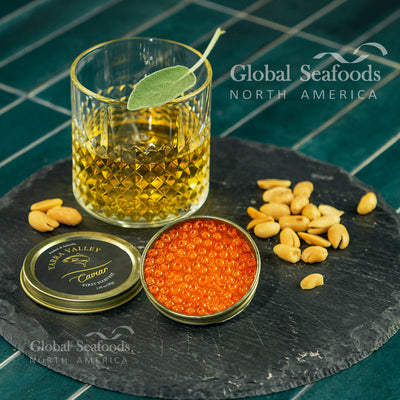What is Salmon Roe? A Delicious Delicacy Explained Salmon Roe

Salmon roe: A Delicacy Explained
If you're a seafood enthusiast, you've probably come across the term "salmon roe" or "red caviar." But do you know what exactly it is? In this blog post, we will dive into the world of salmon roe, exploring its taste, nutritional benefits, preparation methods, and where to buy this delectable delicacy. So, let's unravel the secrets of salmon roe!
What is Salmon Roe?
Salmon roe refers to the reddish-orange, slightly transparent egg mass found inside the bellies of female salmon. The size of the roe can vary depending on the species, ranging from five millimeters for sockeye salmon roe to around one centimeter for chum salmon roe. Good-quality salmon roe boasts a shiny appearance, firm texture, and is packed with dietary proteins, vitamins, and essential omega-3 fatty acids. It goes by various names, including ikura, ikura salmon roe, or simply red caviar.
Caviar: Exploring the Delicacy
Both regular caviar and red caviar are delicious, but there are some key differences. Regular black caviar, made from rare sturgeon fish eggs, is known for its high price and exclusivity. On the other hand, red caviar, which is salmon roe, is more affordable and easily accessible. This makes it a popular choice among seafood enthusiasts looking to indulge in the unique flavor and texture of caviar.
What Does Salmon Roe Taste Like?
Salmon roe has a distinct and acquired taste. It's a love-it-or-hate-it experience, with no middle ground. If you're a fan of umami flavors, you're in for a treat! High-grade salmon roe offers a delightful mix of sweet and salty flavors, reminiscent of the taste of salmon itself. Fresh and good-quality roe has a firm, slightly oily texture without being greasy. When you press the eggs between your tongue and the roof of your mouth, they will break with a satisfying "popping" sound. Inside, the eggs are juicy, with a color and consistency similar to honey.
How is Salmon Roe Made?
Salmon roe goes through a meticulous process to ensure its quality and safety for consumption. Various methods like brining, marinating, curing, and fermenting are used to enhance the flavor profile. The delicate nature of the eggs requires careful handling during harvesting. The usual process involves filleting the fish to remove the entire egg sac (skein) without breaking it. The skein is then soaked in a warm, salt solution before separating the fresh salmon roe from the skein membrane. After rinsing to remove any traces of fish or skin, the roe is cured in a brine solution and then packaged and frozen for optimal freshness.
Salmon Roe Nutrition: A Powerhouse of Goodness
Salmon roe is not only a delicious treat but also a nutritional powerhouse. A serving of wild salmon roe (30 grams) contains approximately 40 calories, 6.3 grams of protein, and 1.8 grams of healthy omega-3 fatty acids, such as eicosapentaenoic acid (EPA) and docosahexaenoic acid (DHA). These essential fatty acids play a crucial role in maintaining heart health, reducing the risk of cardiovascular diseases, and promoting proper functioning of the nervous system. Salmon roe is an excellent natural source of omega-3 fats, as our bodies are not efficient at converting plant-based sources into usable forms of DHA and EPA.
The Many Benefits of Salmon Roe
Beyond proteins and omega-3 fats, salmon roe offers numerous other health benefits. Alaskan salmon roe is rich in selenium, magnesium, iron, sodium, phosphorous, vitamin B, vitamin D, vitamin A, vitamin C, and a potent antioxidant called astaxanthin. Astaxanthin, responsible for the reddish-orange color of salmon and roe, is believed to have protective effects on the skin, increasing its resistance to UV radiation and combating sun damage. Vitamin D in salmon roe is highly bioavailable, surpassing synthetic forms added to fortified foods. Additionally, it is gluten-free and contains zero grams of trans fats, making it suitable for a variety of diets.
Is Salmon Roe Safe to Consume?
Rest assured, stringent processing conditions ensure that salmon roe is safe for consumption. Salmon typically contains lower levels of mercury compared to other fish, and the roe contains even less. Wild-caught salmon also has fewer PCBs and contaminants than farmed salmon. To avoid microbial contamination, it's crucial to store Alaskan salmon roe in the freezer until use and consume it within a few days after opening. Individuals with fish allergies should exercise caution and avoid consuming salmon roe.
Where to Buy Salmon Roe
Finding fresh, wild salmon roe for homemade caviar can be a challenge. Fortunately, there are online options available. Local Japanese or Russian food markets, as well as specialty stores, often carry salmon roe. Online vendors like Global Seafoods are reputable sources for high-quality salmon roe. When purchasing salmon roe, buy only what you need, as it has a limited shelf life.
How to Enjoy Salmon Roe
Salmon roe can be savored in various ways, adding a burst of flavor and texture to your dishes. The simplest and most popular method is to serve it over plain buttered toast or mild-flavored crackers with cream cheese. This allows the caviar's flavor to shine through. Salmon roe can also be used as a garnish for omelets, scrambled eggs, or Russian-style blini pancakes served with sour cream. Additionally, it can be incorporated into pasta, salads, canapés, and even deviled eggs for added crunch and flavor. For a Japanese twist, try preparing salmon roe sushi, where a strip of nori is wrapped around rice and topped with ikura salmon roe.
Conclusion
Salmon roe, also known as red caviar, offers a unique and indulgent culinary experience. Its delightful taste, nutritional benefits, and versatile usage make it a sought-after delicacy among seafood lovers. From its acquisition to preparation and pairing, this blog post has covered everything you need to know about salmon roe. So, go ahead and explore the world of salmon roe, savoring its flavors and enjoying its health benefits.
FAQs:
- How long does homemade salmon roe caviar last in the refrigerator?
- Can I use metal utensils to handle salmon roe?
- Is salmon roe suitable for gluten-free diets?
- Are there any alternatives to salmon roe for omega-3 fats?
- What are some other dishes that pair well with salmon roe?
In conclusion, salmon roe is a delicacy that delights the taste buds while offering a wealth of nutrients. Its unique flavor, texture, and versatility in recipes make it a sought-after ingredient. Whether enjoyed simply on toast or incorporated into various dishes, salmon roe is sure to impress seafood enthusiasts and culinary adventurers
Also in News

How to Make Sea Bream Sushi With Dry-Aged Tuna & Crab Roll — Step-by-Step With Chef Joshua
A complete guide to making Sea Bream sushi at home, including filleting, curing, slicing, and building a Dry-Aged Tuna & Crab sushi roll. Chef Joshua shares professional tips for restaurant-quality results.

Boiled Crab for Game Night: Everything You Need for a Perfect Seafood Party
Take your game night to the next level with a Boiled crab party. Learn the best recipes, cooking tips, and hosting hacks for a memorable seafood feast.

Boiled Crab for Date Night: A Romantic Guide to the Perfect Seafood Feast
Make your next date night unforgettable with a romantic Boiled crab experience. This guide covers everything you need to know, from ambiance to the best crab varieties.









